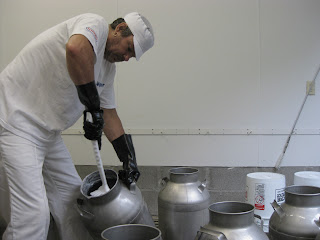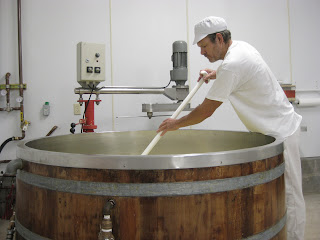While in the Ticino area in Switzerland, I visited some cheesemakers. The Ticino is in the south of Switzerland near the Italian border. This creamery was in the mountains just passed Fusio, a little village in Vallemachia (Magic Valley). In 2004 the creamery and the alps (summer pastures in the mountains) were renovated and modernized by the local patricians with the financial help of several Swiss foundations which aim to keep the local traditions alive. The creamery is rented to cheesemakers at cost. The
cheesemakers who were using it when I visited were an Italian family of four, Lorena, her husband, son and father. They spend three months in the summer taking care of a local herd of cows and goats and make cheese from the milk. The rest of the year they live in Italy where they have a dairy farm and also make cheese. When they are in Switzerland, the milk produced by their Italian farm is sold as fluid milk.
The Swiss creamery I visited is at a height of 1500 meter (5000 ft). Lorena was making cheese, while the husband and son were on higher grounds with the cows and goats. The animals are milked t
wice a day and the milk comes down to the creamery through a pipeline; this is about 2,5 km (1.5 miles) long and buried in the ground. Before milk is fed through the line, it is cleaned by forcing about 8 balls through it using water and cleaning fluids. The balls are spongy, mildly abrasive and slightly larger than the inner diameter of the line. As such, they clean the inner wall of the plastic pipeline.
When I arrived, Lorena had just finished filling the large vat with cow's milk while the father was moving cheeses made the previous day to the cave. After the milk stopped flowing, water came through the milk line followed by the goat's milk which was run into a smaller vat next the large vat. The large vat was a modern Italian-made vat of 1000 liter (265 gallon). The inside was copper while the remaining material was stainless steel. It was heated by moving steam through the double jacket. The smaller vat was a traditional copper vat of about 100 liter (26.5 gallon) capacity. It sat on a steel base and was also steam heated. The steam was produced by a wood burning furnace.
When the milk reached the correct temperature, Lorena added the rennet, stirred the milk for a minute or two and waited 30 minutes for it to coagulate. When the milk had set, she cut the curd with a harp making smooth and sweeping moves; the curd looked silky and easy to cut. After cutting the curds into long serpentines, she took a break to sell some cheese to customers who had walked up the mountain. If this pause in cutting was a prescribed part of the procedure, I don't know. After about 5 minutes, she continued cutting, now with faster and more forceful moves, until the curds were rice sized particles.
Subsequently, she started cooking the curds. She lowered the paddle into the fluid, added a current cutter and hung a large glass thermometer in the whey. She cooked the curds over about 40 minutes to 45 degrees Celsius (113 F). In between these operations she cleaned the tools in the sink and sprayed the floor clean with water. But now it was time for a pause so she went out to have a cigarette.
After about 30 minutes of heating, she checked the temperature which had reached 45 degrees. She stopped the steam. Then she took some curds from the whey, squeezed them and rubbed them between her fingers, checking the consistency. Another 10 minutes she said. She gave the curds to me. Indeed they seemed a little too soft and didn't knead well. When ten minutes had passed, she stopped the stirrer, lifted the paddles from the whey and sprayed them clean with water.
Now it was time to prepare the hoops. Earlier she had shown me the hoops and how they work. The ones she used were made of plastic and are much easier to adjust than the wooden ones. She prepared 8 hoops with linen cheesecloth which had been drying outside. While the hoops were being prepared, the curd had had time to settle on the bottom on the vat and was now ready to be gathered and drained. I have seen cheesemakers in the Alps who use a flexible stainless steel bar on which they string one side of a large square piece of cloth. While holding the adjacent two corners between their teeth, they plunge into the vat, sometimes held by their feet, and gather the curd into the cloth. So I was anticipating this part of the process, wondering who would jump into the vat. However, even though they used the same technique to collect the curd, they had a more complex contraption which didn't require plunging head first into the vat. Basically it was a stainless steel shape, pre-formed to the inside shape of the vat with a long oblong shaped handle to guide the pre-formed shape through the vat. Lorena attached a large piece of linen to the contraption using pins and knots. With the help of her father, she collected the curds from the whey and attached the cloth to a hoist. Dad hoisted the dripping curds from they whey and they lowered the mass onto a draining table. Lorena spread the curds into a adjustable square on the draining table and cut the mass into 8 equal pieces which she put into the hoops. When all the hoops were full, she went back to the first hoop, kneading the curds into the hoops, pressing hard using her whole body, tightening the cloth and tucking it in. Sometimes she would adjust the hoop, make it bigger or smaller depending on the amount of curd. When all the hoops were done, she stacked them on the pressing table, put a corian board on top and placed a stainless steel cross on top of this to spread the pressure evenly. After some adjustments of the pressing table she cranked the big screw and the cheeses started to drip little faster.
On other days she would have started to make ricotta now, but this was skipped because it was Sunday. So, a feast day for the pigs.
I didn't wait for the turning of the cheeses, neither the finishing of the making of the goat cheese which Lorena had renneted, cut and cooked between several operations of the cow cheese. Her father had been stirring the curds with a wooden paddle while heating, complaining that his arm was getting stiff. My party was getting hungry, it was time for lunch.























































